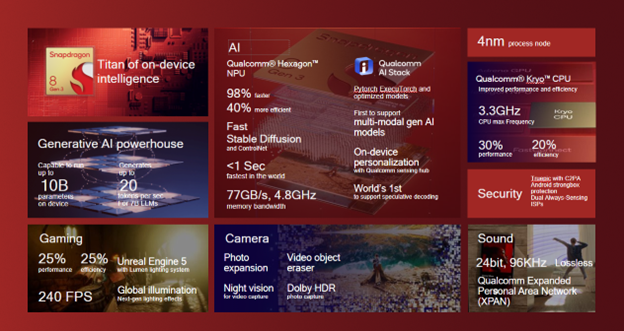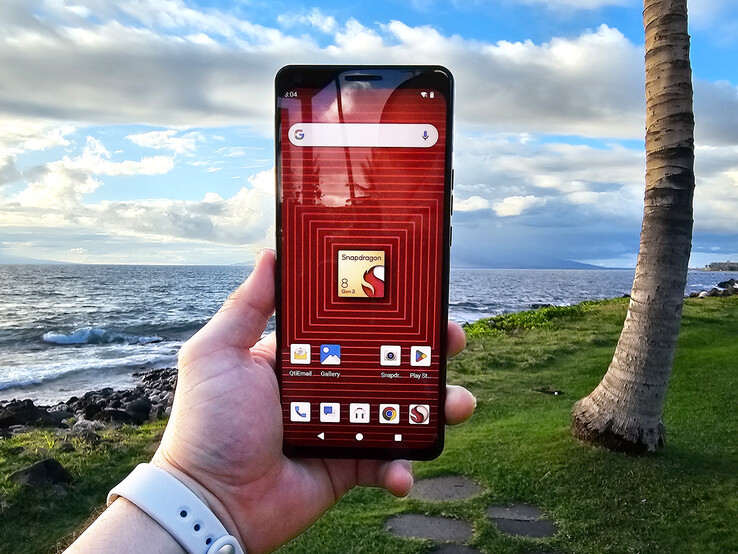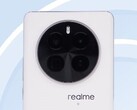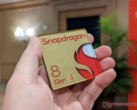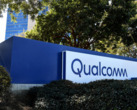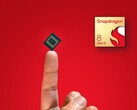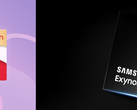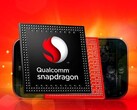Every year in Hawaii, Qualcomm sets its own stage for its high-end products as part of the Snapdragon Summit - and this year is no exception. The main focus is on the top-end SoC for all Android devices: the Snapdragon 8 Gen 3 (SM8650-AB).
A little surprisingly, rather than opting for 3 nm architecture, Qualcomm, instead, continues to go with 4 nm and ARMv9.2. As with its predecessors, the SoC will once again be manufactured by TSMC. The chip's AI and ML abilities have been greatly expanded and improved. The NPU alone delivers 98 percent higher performance and can now handle even more up-to-date AI models as well as INT4. On top of that, almost every subsystem now possesses its own AI acceleration.
Additional features have also been added and upgraded. At 3.5 GBit/s, the Snapdragon X75 modem delivers higher upload speeds than its predecessor. Likewise, Wi-Fi 7 is onboard again, but Bluetooth 5.4 with LE audio is new. The LPDDR5x RAM now runs at 4,800 MHz.
However, the centrepiece is still the CPU and the GPU. The former continues to be based on eight cores but these are organized differently: The first cluster is occupied by a prime core (Cortex X4) that runs at 3.3 GHz and this is joined by five performance cores (all Cortex A720) from which three operate at up to 3.2 GHz and two at up to 3.0 GHz. In the third cluster, there are two efficiency cores (Cortex A520) which run at up to 2.3 GHz.
This year, we have not (so far) been able to carry out any of our own benchmarks. Instead, Qualcomm has entrusted us with the corresponding benchmark results for the Snapdragon 8 Gen 3. In recent years, we additionally received these and they were always in keeping with our own results. This year, the basis for the benchmarks is served by a so-called Qualcomm Reference Design (QRD) that possesses a 6.65-inch AMOLED display (2,340 x 1,080 pixels, at up to 144 Hz) and has 24 GB of LPDDR5x RAM as well as 512 GB of UFS 4.0 storage at its disposal. The device's battery packs 4,192 mAh and is powered by the Android 14 operating system.
The CPU performance is impressive. As expected, the single-core performance in Geekbench 6.1 can't keep up with an Apple A17 Pro but when all of the cores work together, the Snapdragon 8 Gen 3 has its nose in front. Also, in comparison to its predecessor, the new Qualcomm SoC ups the ante greatly and even manages to achieve a plus of up to 57 percent.
In AnTuTu, the increase is also significant and the Snapdragon 8 Gen 3 easily manages to beat the iPhone 15 Pro Max. A look at the individual sub-scores shows this is especially attributed to the considerably stronger GPU performance.
| Geekbench 6.5 | |
| Single-Core | |
| Apple iPhone 15 Pro Max | |
| Snapdragon 8 Gen 3 Reference Design | |
| Honor Magic5 Pro | |
| Google Pixel 8 Pro | |
| Xiaomi 13T Pro | |
| Multi-Core | |
| Snapdragon 8 Gen 3 Reference Design | |
| Apple iPhone 15 Pro Max | |
| Honor Magic5 Pro | |
| Google Pixel 8 Pro | |
| Xiaomi 13T Pro | |
| Antutu v10 | |
| Total Score | |
| Snapdragon 8 Gen 3 Reference Design | |
| Apple iPhone 15 Pro Max | |
| Honor Magic5 Pro | |
| Google Pixel 8 Pro | |
| CPU | |
| Snapdragon 8 Gen 3 Reference Design | |
| Apple iPhone 15 Pro Max | |
| Google Pixel 8 Pro | |
| Honor Magic5 Pro | |
| GPU | |
| Snapdragon 8 Gen 3 Reference Design | |
| Honor Magic5 Pro | |
| Apple iPhone 15 Pro Max | |
| Google Pixel 8 Pro | |
| MEM | |
| Snapdragon 8 Gen 3 Reference Design | |
| Honor Magic5 Pro | |
| Apple iPhone 15 Pro Max | |
| Google Pixel 8 Pro | |
| UX | |
| Snapdragon 8 Gen 3 Reference Design | |
| Apple iPhone 15 Pro Max | |
| Honor Magic5 Pro | |
| Google Pixel 8 Pro | |
| PCMark for Android - Work 3.0 | |
| Snapdragon 8 Gen 3 Reference Design | |
| Asus ROG Phone 7 Ultimate | |
| Qualcomm Snapdragon 8 Gen 2 Reference Device | |
| Samsung Galaxy S23 Ultra | |
| Honor Magic5 Pro | |
| Xiaomi 13T Pro | |
| Google Pixel 8 Pro | |
| AImark - Score v3.x | |
| Snapdragon 8 Gen 3 Reference Design | |
| Qualcomm Snapdragon 8 Gen 2 Reference Device | |
| Apple iPhone 15 Pro Max | |
| Asus ROG Phone 7 Ultimate | |
| Samsung Galaxy S23 Ultra | |
| Honor Magic5 Pro | |
| Google Pixel 8 Pro | |
| Xiaomi 13T Pro | |
| Jetstream 2 - 2.0 Total Score | |
| Apple iPhone 15 Pro Max | |
| Snapdragon 8 Gen 3 Reference Design | |
| Samsung Galaxy S23 Ultra | |
| Xiaomi 13T Pro | |
| Asus ROG Phone 7 Ultimate | |
| Honor Magic5 Pro | |
| Google Pixel 8 Pro | |
| Qualcomm Snapdragon 8 Gen 2 Reference Device | |
| Speedometer 2.0 - Result 2.0 | |
| Apple iPhone 15 Pro Max | |
| Snapdragon 8 Gen 3 Reference Design | |
| Xiaomi 13T Pro | |
| Google Pixel 8 Pro | |
| Samsung Galaxy S23 Ultra | |
| Honor Magic5 Pro | |
| Asus ROG Phone 7 Ultimate | |
| Qualcomm Snapdragon 8 Gen 2 Reference Device | |
| WebXPRT 3 - Overall | |
| Snapdragon 8 Gen 3 Reference Design | |
| Apple iPhone 15 Pro Max | |
| Asus ROG Phone 7 Ultimate | |
| Xiaomi 13T Pro | |
| Google Pixel 8 Pro | |
| Qualcomm Snapdragon 8 Gen 2 Reference Device | |
The internal graphics unit comes in the form of the Adreno 750, regarding which Qualcomm has once more only provided rudimentary details. The performance is said to be 25 percent higher than the Adreno 740 in the Snapdragon 8 Gen 2. At the same time, they claim its efficiency has improved by around 25 percent. Hardware-based ray tracing is nothing new for Qualcomm but this is supposedly also an area where tangible improvements can be found. One highlight is certainly the upscaling of games to 8K as well as the Frame Motion Engine 2.0 that is said to boost games from a nominal 60 fps to 120 fps. Gaming at 240 fps should also be possible.
The Adreno 750 really shines in benchmarks when the Vulkan API is used and this ensured a GFXBench performance increase of 16 percent compared to the same benchmark with OpenGL ES 3.1. But, the Qualcomm GPU also delivers nearly double as many frames as the A17 Pro with the older API - impressive.
In terms of 3DMark, Qualcomm has only provided us with onscreen figures. In this area, the Snapdragon 8 Gen 5's Adreno 750 is considerably faster than the competition but it also has the lowest PPI, meaning the performance difference in the offscreen tests will certainly be somewhat lower. Nevertheless, the ray tracing scores (Solar Bay) are in a league of their own.
3DMark: Wild Life Score | Wild Life Extreme | Solar Bay Score
| GFXBench / Aztec Ruins High Tier Offscreen | |
| Snapdragon 8 Gen 3 Reference Design (Vulkan) | |
| Snapdragon 8 Gen 3 Reference Design (OpenGL ES 3.1) | |
| Honor Magic5 Pro | |
| Samsung Galaxy S23 Ultra | |
| Qualcomm Snapdragon 8 Gen 2 Reference Device (Vulkan 1.0) | |
| Qualcomm Snapdragon 8 Gen 2 Reference Device (OpenGL ES 3.1) | |
| Asus ROG Phone 7 Ultimate | |
| Apple iPhone 15 Pro Max | |
| Xiaomi 13T Pro | |
| Google Pixel 8 Pro | |
| GFXBench / Aztec Ruins Normal Tier Offscreen | |
| Snapdragon 8 Gen 3 Reference Design | |
| Asus ROG Phone 7 Ultimate | |
| Samsung Galaxy S23 Ultra | |
| Qualcomm Snapdragon 8 Gen 2 Reference Device (Vulkan 1.0) | |
| Qualcomm Snapdragon 8 Gen 2 Reference Device (OpenGL ES 3.1) | |
| Xiaomi 13T Pro | |
| Honor Magic5 Pro | |
| Apple iPhone 15 Pro Max | |
| Google Pixel 8 Pro | |
| 3DMark / Wild Life Score | |
| Snapdragon 8 Gen 3 Reference Design | |
| Google Pixel 8 Pro | |
| Honor Magic5 Pro | |
| Asus ROG Phone 7 Ultimate | |
| 3DMark / Wild Life Extreme | |
| Snapdragon 8 Gen 3 Reference Design | |
| Samsung Galaxy S23 Ultra | |
| Asus ROG Phone 7 Ultimate | |
| Apple iPhone 15 Pro Max | |
| Honor Magic5 Pro | |
| Xiaomi 13T Pro | |
| Google Pixel 8 Pro | |
| 3DMark / Solar Bay Score | |
| Snapdragon 8 Gen 3 Reference Design | |
| Apple iPhone 15 Pro Max | |
| Honor Magic5 Pro | |
| Xiaomi 13T Pro | |
With the Snapdragon 8 Gen 3, Qualcomm has showcased a strong upgrade that not only takes a leap forward when it comes to performance but can also cope with all modern APIs, decoders and AI models. This ensures that forthcoming owners will be perfectly equipped for the future.
Source(s)
Qualcomm





